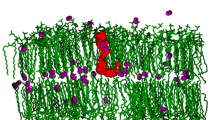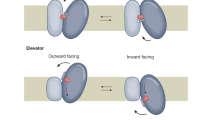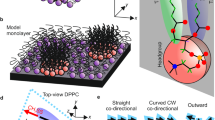Abstract
Homochiral membrane bilayers organize biological functions in all domains of life. The membrane’s permeability—its key property—correlates with a molecule’s lipophilicity, but the role of the membrane’s rich and uniform stereochemistry as a permeability determinant is largely ignored in empirical and computational measurements. Here, we describe a new approach to measuring permeation using continuously generated microfluidic droplet interface bilayers (DIBs, generated at a rate of 480 per minute) and benchmark this system by monitoring fluorescent dye DIB permeation over time. Enantioselective permeation of alkyne-labelled amino acids (Ala, Val, Phe, Pro) and dipeptides through a chiral phospholipid bilayer was demonstrated using DIB transport measurements; the biological l enantiomers permeated faster than the d enantiomers (from 1.2-fold to 6-fold for Ala to Pro). Enantioselective permeation both poses a potentially unanticipated criterion for drug design and offers a kinetic mechanism for the abiotic emergence of homochirality via chiral transfer between sugars, amino acids and lipids.

This is a preview of subscription content, access via your institution
Access options
Access Nature and 54 other Nature Portfolio journals
Get Nature+, our best-value online-access subscription
$29.99 / 30 days
cancel any time
Subscribe to this journal
Receive 12 print issues and online access
$259.00 per year
only $21.58 per issue
Buy this article
- Purchase on Springer Link
- Instant access to full article PDF
Prices may be subject to local taxes which are calculated during checkout




Similar content being viewed by others
Data availability
Data supporting the findings of this study are available within this article and its Supplementary Information. Raw data of main figures in the article are available from figshare at https://figshare.com/s/b387496fed3d3befd61d.
Code availability
The R code for general data analysis is available from figshare at https://figshare.com/s/b387496fed3d3befd61d.
References
Luisi, P. L., Walde, P. & Oberholzer, T. Lipid vesicles as possible intermediates in the origin of life. Curr. Opin. Colloid Interface Sci. 4, 33–39 (1999).
Deamer, D. W. & Dworkin, J. P. Chemistry and physics of primitive membranes. Top. Curr. Chem. 259, 1–27 (2005).
Joyce, G. F. & Szostak, J. W. Protocells and RNA self-replication. Cold Spring Harb. Perspect. Biol. 10, a034801 (2018).
Overton, E. Vierteljahrsschr. Naturforsch. Ges. Zurich 44, 88–135 (1899).
Al-Awqati, Q. One hundred years of membrane permeability: does Overton still rule? Nat. Cell Biol. 1, E201–E202 (1999).
Sacerdote, M. G. & Szostak, J. W. Semipermeable lipid bilayers exhibit diastereoselectivity favoring ribose. Proc. Natl Acad. Sci. USA 102, 6004–6008 (2005).
Smith, D. J., Leal, L. G., Mitragotri, S. & Shell, M. S. Nanoparticle transport across model cellular membranes: When do solubility-diffusion models break down? J. Phys. D: Appl. Phys. 51, 4004 (2018).
Corti, G., Maestrelli, F., Cirri, M., Zerrouk, N. & Mura, P. Development and evaluation of an in vitro method for prediction of human drug absorption: II. Demonstration of the method suitability. Eur. J. Pharm. Sci. 27, 354–362 (2006).
Sato, K., Ji, W., Álvarez, Z., Palmer, L. C. & Stupp, S. I. Chiral recognition of lipid bilayer membranes by supramolecular assemblies of peptide amphiphiles. ACS Biomater. Sci. Eng. 5, 2786–2792 (2019).
Henriques, S. T., Peacock, H., Benfield, A. H., Wang, C. K. & Craik, D. J. Is the mirror image a true reflection? Intrinsic membrane chirality modulates peptide binding. J. Am. Chem. Soc. 141, 20460–20469 (2019).
Ishigami, T., Suga, K. & Umakoshi, H. Chiral recognition of l-amino acids on liposomes prepared with l-phospholipid. ACS Appl. Mater. Interfaces 7, 21065–21072 (2015).
Funakoshi, K., Suzuki, H. & Takeuchi, S. Lipid bilayer formation by contacting monolayers in a microfluidic device for membrane protein analysis. Anal. Chem. 78, 8169–8174 (2006).
Venkatesan, G. A. et al. Adsorption kinetics dictate monolayer self-assembly for both lipid-in and lipid-out approaches to droplet interface bilayer formation. Langmuir 31, 12883–12893 (2015).
Holden, M. A., Needham, D. & Bayley, H. Functional bionetworks from nanoliter water droplets. J. Am. Chem. Soc. 129, 8650–8655 (2007).
Bayley, H. et al. Droplet interface bilayers. Mol. Biosyst. 4, 1191–1208 (2008).
Maglia, G. et al. Droplet networks with incorporated protein diodes show collective properties. Nat. Nanotechnol. 4, 437–440 (2009).
Shieh, P. et al. CalFluors: a universal motif for fluorogenic azide probes across the visible spectrum. J. Am. Chem. Soc. 137, 7145–7151 (2015).
Tsofina, L. M., Liberman, E. A. & Babakov, A. V. Production of bimolecular protein-lipid membranes in aqueous solution. Nature 212, 681–683 (1966).
Xu, L., Lee, H., Panchapakesan, R. & Oh, K. W. Fusion and sorting of two parallel trains of droplets using a railroad-like channel network and guiding tracks. Lab Chip 12, 3936 (2012).
Abbyad, P., Dangla, R., Alexandrou, A. & Baroud, C. N. Rails and anchors: guiding and trapping droplet microreactors in two dimensions. Lab Chip 11, 813–821 (2011).
Holden, M. A., Needham, D. & Bayley, H. Functional bionetworks from nanoliter water droplets. J. Am. Chem. Soc. 129, 8650–8655 (2007).
Czekalska, M. A., Kaminski, T. S., Makuch, K. & Garstecki, P. Passive and parallel microfluidic formation of droplet interface bilayers (DIBs) for measurement of leakage of small molecules through artificial phospholipid membranes. Sensors Actuators, B 286, 258–265 (2019).
Carreras, P. et al. A microfluidic platform for size-dependent generation of droplet interface bilayer networks on rails. Biomicrofluidics 9, 1–7 (2015).
Bai, Y. et al. A double droplet trap system for studying mass transport across a droplet-droplet interface. Lab Chip 10, 1281–1285 (2010).
Barlow, N. E. et al. Rheological droplet interface bilayers (rheo-DIBs): Probing the unstirred water layer effect on membrane permeability via spinning disk induced shear stress. Sci. Rep. 7, 1–12 (2017).
Fischer, H., Kansy, M., Avdeef, A. & Senner, F. Permeation of permanently positive charged molecules through artificial membranes—influence of physico-chemical properties. Eur. J. Pharm. Sci. 31, 32–42 (2007).
Huang, J. & Feigenson, G. W. A microscopic interaction model of maximum solubility of cholesterol in lipid bilayers. Biophys. J. 76, 2142–2157 (1999).
Song, H. & Ismagilov, R. F. Millisecond kinetics on a microfluidic chip using nanoliters of reagents. J. Am. Chem. Soc. 125, 14613–14619 (2003).
Stone, Z. B. & Stone, H. A. Imaging and quantifying mixing in a model droplet micromixer. Phys. Fluids 17, 1–11 (2005).
Kolb, H. C., Finn, M. G. & Sharpless, K. B. Click chemistry: diverse chemical function from a few good reactions. Angew. Chem. Int. Ed. 40, 2004–2021 (2001).
Morimoto, J., Amano, R., Ono, T. & Sando, S. A parallel permeability assay of peptides across artificial membranes and cell monolayers using a fluorogenic reaction. Org. Biomol. Chem. 17, 2887–2891 (2019).
Chen, Y. H., Sung, P. H. & Sung, K. Synthesis of proline-derived dipeptides and their catalytic enantioselective direct aldol reactions: catalyst, solvent, additive and temperature effects. Amino Acids 38, 839–845 (2010).
Tang, Z. et al. Small peptides catalyze highly enantioselective direct aldol reactions of aldehydes with hydroxyacetone: Unprecedented regiocontrol in aqueous media. Org. Lett. 6, 2285–2287 (2004).
Budin, I. & Szostak, J. W. Physical effects underlying the transition from primitive to modern cell membranes. Proc. Natl Acad. Sci. USA 108, 5249–5254 (2011).
Hauß, T., Dante, S., Dencher, N. A. & Haines, T. H. Squalane is in the midplane of the lipid bilayer: Implications for its function as a proton permeability barrier. Biochim. Biophys. Acta - Bioenerg. 1556, 149–154 (2002).
Arranz-Gibert, P. et al. Lipid bilayer crossing-the gate of symmetry. Water-soluble phenylproline-based blood-brain barrier shuttles. J. Am. Chem. Soc. 137, 7357–7364 (2015).
Blackmond, D. G. The origin of biological homochirality. Cold Spring Harb. Perspect. Biol. 11, a032540 (2019).
Viedma, C. Chiral symmetry breaking during crystallization: Complete chiral purity induced by nonlinear autocatalysis and recycling. Phys. Rev. Lett. 94, 065504 (2005).
Noorduin, W. L. et al. Emergence of a single solid chiral state from a nearly racemic amino acid derivative. J. Am. Chem. Soc. 130, 1158–1159 (2008).
Viedma, C., Ortiz, J. E., De Torres, T., Izumi, T. & Blackmond, D. G. Evolution of solid phase homochirality for a proteinogenic amino acid. J. Am. Chem. Soc. 130, 15274–15275 (2008).
Soai, K., Shibata, T., Morioka, H. & Choji, K. Excess of a chiral molecule. Nature 378, 767–768 (1995).
Blackmond, D. G., McMillan, C. R., Ramdeehul, S., Schorm, A. & Brown, J. M. Origins of asymmetric amplification in autocatalytic alkylzinc additions. J. Am. Chem. Soc. 123, 10103–10104 (2001).
Blackmond, D. G. Autocatalytic models for the origin of biological homochirality. Chem. Rev. 120, 4831–4847 (2019).
Wagner, A. J., Zubarev, D. Y., Aspuru-Guzik, A. & Blackmond, D. G. Chiral sugars drive enantioenrichment in prebiotic amino acid synthesis. ACS Cent. Sci. 3, 322–328 (2017).
Zhu, T. F. & Szostak, J. W. Coupled growth and division of model protocell membranes. J. Am. Chem. Soc. 131, 5705–5713 (2009).
Weber, A. L. & Pizzarello, S. The peptide-catalyzed stereospecific synthesis of tetroses: A possible model for prebiotic molecular evolution. Proc. Natl Acad. Sci. USA 103, 12713–12717 (2006).
Adamala, K. & Szostak, J. W. Competition between model protocells driven by an encapsulated catalyst. Nat. Chem. 5, 495–501 (2013).
Gillams, R. & Jia, T. Mineral surface-templated self-assembling systems: Case studies from nanoscience and surface science towards origins of life research. Life 8, 10 (2018).
Danger, G., Charlot, S., Boiteau, L. & Pascal, R. Activation of carboxyl group with cyanate: peptide bond formation from dicarboxylic acids. Amino Acids 42, 2331–2341 (2012).
Leman, L., Orgel, L. & Ghadiri, M. R. Carbonyl sulfide-mediated prebiotic formation of peptides. Science 306, 283–286 (2004).
Green, M. M. et al. Macromolecular stereochemistry: the out-of-proportion influence of optically active comonomers on the conformational characteristics of polyisocyanates. the sergeants and soldiers experiment. J. Am. Chem. Soc. 111, 6452–6454 (1989).
Palmans, A. R. A. & Meijer, E. W. Amplification of chirality in dynamic supramolecular aggregates. Angew. Chem. Int. Ed. 46, 8948–8968 (2007).
Morigaki, K., Dallavalle, S., Walde, P., Colonna, S. & Luisi, P. L. Autopoietic self-reproduction of chiral fatty acid vesicles. J. Am. Chem. Soc. 119, 292–301 (1997).
Grahame, D. A. S. et al. Influence of chirality on the modes of self-assembly of 12-hydroxystearic acid in molecular gels of mineral oil. Soft Matter 7, 7359–7365 (2011).
Peng, J. et al. New dicholesteryl-based gelators: Chirality and spacer length effect. Langmuir 24, 2992–3000 (2008).
Chen, I. A., Roberts, R. W. & Szostak, J. W. The emergence of competition between model protocells. Science 305, 1474–1476 (2004).
Breslow, R. & Cheng, Z. L. l-amino acids catalyze the formation of an excess of d-glyceraldehyde, and thus of other d sugars, under credible prebiotic conditions. Proc. Natl Acad. Sci. USA 107, 5723–5725 (2010).
Hein, J. E., Tse, E. & Blackmond, D. G. A route to enantiopure RNA precursors from nearly racemic starting materials. Nat. Chem. 3, 704–706 (2011).
Price, A. K., MacConnell, A. B. & Paegel, B. M. hνSABR: photochemical dose-response bead screening in droplets. Anal. Chem. 88, 2904–2911 (2016).
Cochrane, W. G. et al. Activity-based DNA-encoded library screening. ACS Comb. Sci. 21, 425–435 (2019).
Acknowledgements
Funding from the Simons Foundation through the Simons Collaboration on the Origins of Life (SCOL 287625), the National Institutes of Health (R01GM120491) and the National Science Foundation (1255250) is gratefully acknowledged.
Author information
Authors and Affiliations
Contributions
J.H., W.G.C. and B.M.P. conceived the research. J.H. performed the experiments. D.G.B. guided the experimental design related to dipeptides. A.X.J. synthesized and characterized dipeptides. J.H. and B.M.P. analysed the data. All authors wrote the manuscript.
Corresponding author
Ethics declarations
Competing interests
The authors declare no competing interests.
Additional information
Peer review information Nature Chemistry thanks the anonymous reviewers for their contribution to the peer review of this work.
Publisher’s note Springer Nature remains neutral with regard to jurisdictional claims in published maps and institutional affiliations.
Supplementary information
Supplementary Information
Supplementary Figs. 1–9, methods and data analysis.
Supplementary Video 1
Droplet generator.
Supplementary Video 2
Droplet synchronizer1_Start.
Supplementary Video 3
Droplet synchronizer2_End.
Supplementary Video 4
Entrance of incubator.
Supplementary Video 5
DIB trains in the incubator.
Rights and permissions
About this article
Cite this article
Hu, J., Cochrane, W.G., Jones, A.X. et al. Chiral lipid bilayers are enantioselectively permeable. Nat. Chem. 13, 786–791 (2021). https://doi.org/10.1038/s41557-021-00708-z
Received:
Accepted:
Published:
Issue Date:
DOI: https://doi.org/10.1038/s41557-021-00708-z
This article is cited by
-
Droplet-based microfluidics
Nature Reviews Methods Primers (2023)



